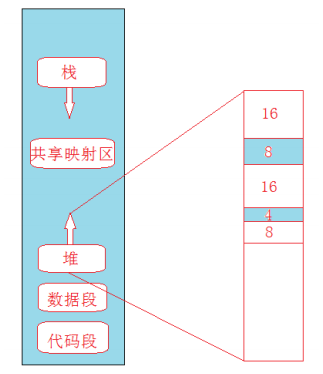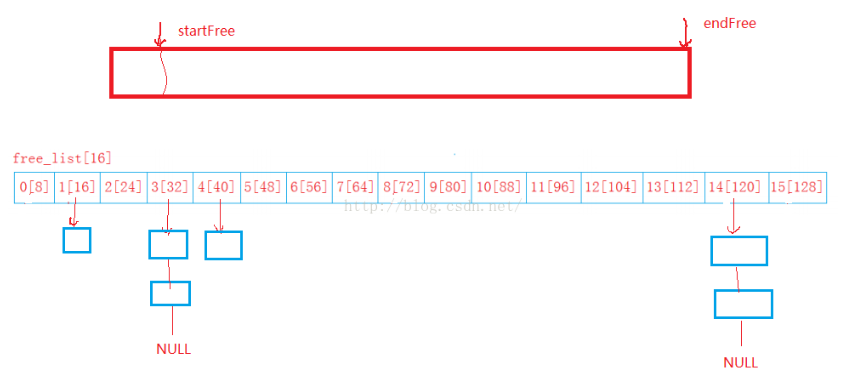1、爲什麼需要空間配置器?
內存碎片:
![QQ圖片20160728204229.png wKiom1eZ_WLQu_9ZAABFcCEAMIo360.png]()
頻繁分配小內存導致分配不出來大內存,這就是外碎片;並且頻繁分配小內存效率低
比如,系統依次分配了16、8、16、4、8byte,還剩一個8byte未分配,這時要分配一個24byte的空間,系統回收兩個16byte,總的空間剩餘40byte, 但是卻分配不出來一個24byte。
二級空間配置器是爲頻繁分配小內存而生的一種算法,其實就是消除一級空間配置器的外碎片問題
2、一級空間配置器和二級空間配置器
![QQ圖片20160728210445.png wKiom1eaApfgJ7AgAAFBbLlx7KU781.png]()
如果申請的內存大小超過128,那麼空間配置器就自動調用一級空間配置器。反之調用二級空間配置器。而且在這裏要說明的是空間配置器默認使用的是一級空間配置器。
一、一級空間配置器
一級空間配置器是malloc-free的封裝,實現類似C++中new-handler機制:一旦申請空間不成功,在丟出bad-allloc異常之前,會先調用用戶自己指定的處理例程new-handler()。
一級空間配置器的allocate()和reallocate()都是在調用malloc和realloc不成功時,改調用oom_malloc和oom_realloc,後兩者都能循環調用內存不足處理例程,期待在某次調用之後可以獲得足夠內存而達到目的 ,但是若處理例程未被用戶設定,oom_malloc和oom_realloc便會拋出bad-alloc的異常或用exit(1)終止程序。
代碼如下:
// 一級空間配置器(malloc/realloc/free) template<int inst> //非類型模板參數
class MallocAllocTemplate
{ //1:分配內存成功,則直接返回
//2:若分配失敗,則檢查是否設置處理的句柄handler
//有則調用以後再分配,不斷重複這個過程,直到分配成功爲止.
//沒有設置處理的句柄handler,則直接結束程序
public:
static void* Allocate(size_t size) //用於分配空間 {
void* ret = malloc(size);
if (0 == ret)
{
ret = OomMalloc(size);
}
return ret;
} static void Deallocate(void* p) //收回
{
free(p);
} static void* Reallocate(void* p, size_t newsize) //用於指定地址重新分配空間
{
void* ret = realloc(p, newsize);
if (ret == 0)
{
ret = OomRealloc(p, newsize);
}
return ret;
}
private:
static void* OomMalloc(size_t size) //調用自定義的句柄處理函數handler釋放並分配內存
{
ALLOC_FUN handler;
void* ret;
while (1)
{
handler = MallocAllocHandler;
if (0 == handler)
{
cout << "out of memory" << endl;
exit(-1);
} handler();
ret = malloc(size);
if (ret)
{
return(ret);
}
}
} static void* OomRealloc(void*p, size_t newsize)
{
ALLOC_FUN handler;
void* ret;
while (1)
{
handler = MallocAllocHandler;
if (0 == handler)
{
cout << "out of memory" << endl;
exit(-1);
} handler();
ret = realloc(newsize);
if (ret)
{
return(ret);
}
}
}
static void(*SetMallocHandler(void(*f)()))(); //設置操作系統分配內存失敗時的句柄處理函數
{
void(*tmp)() = MallocAllocHandler;
MallocAllocHandler = f;
return(tmp);
}
};
template<int inst>
ALLOC_FUN MallocAllocTemplate<inst>::MallocAllocHander = 0; //句柄函數初始化爲0
|
二、二級空間配置器
二級空間配置器是由一個內存池和自由鏈表配合實現的
![QQ圖片20160728212005.png wKioL1eaDyngajtIAAB6my4CU3k260.png]()
startFree相當於水位線,標誌內存池的大小
自由鏈表中其實是一個大小爲16的指針數組,間隔爲8的倍數。各自管理大小分別爲8,16,24,32,40,48,56,64,72,80,88,96,104, 112,120,128 字節的小額區塊。在每個下標下掛着一個鏈表,把同樣大小的內存塊鏈接在一起。類似於哈希桶。
代碼如下:
// 二級空間配置器
template<bool threads,int inst>
class DefaultallocTemplate //二級空間配置器
{
public:
enum{ ALIGN = 8 }; //基準值對齊
enum{ MAX_BYTES = 128 }; //最大字節
enum{ FREELISTS = MAX_BYTES / ALIGN }; //自由鏈表大小
union obj
{
union obj* listLink; //自由鏈表中指向下一個內存塊的指針
char clientData[1]; //調試用
};
static size_t FreeListIndex(size_t bytes) //得到所需內存塊在自由鏈表中的下標
{
return ((bytes + ALIGN - 1) / ALIGN - 1);
}
static size_t RoundUpNum(size_t bytes) //得到內存塊大小的向上對齊數(8的倍數)
{
return (bytes + ALIGN - 1)&~(ALIGN - 1);
}
static obj* FreeList[FREELISTS]; //維護自由鏈表
static char* startFree; //水位線(維護內存池)
static char* endFree; //池底
static size_t heapSize;
static void* Allocate(size_t size)
{
if (size > MAX_BYTES)
{
return MallocAllocTemplate<inst>::Allocate(size);
}
void* ret = NULL;
size_t index = FreeListIndex(size); if (FreeList[index]) //自由鏈表上有內存塊
{
obj* ret = FreeList[index]; //取走當前下標的第一個給用戶
FreeList[index] = ret->listLink; //FreeList[index]指向下一個
}
else //若自由鏈表沒有,則調用refill從內存池填充自由鏈表並返回內存池的第一個內存塊
{
return Refill(RoundUpNum(size));
}
return ret;
} static void* Reallocate(void* p, size_t oldsize, size_t newsize)
{
void* ret = NULL;
if (oldsize > (size_t)MAX_BYTES&&newsize > (size_t)MAX_BYTES)
return (realloc(p, newsize));
if (RoundUpNum(oldsize) == RoundUpNum(newsize))
return p;
ret = Allocate(newsize);
size_t copysize = oldsize > newsize ? newsize : oldsize;
memcopy(ret, p, copysize);
DeAllocate(p, oldsize);
return ret;
}
static void Deallocate(void* p, size_t size)
{
if (size> MAX_BYTES) //如果大於MAX_BYTES直接交還給一級空間配置器釋放
return MallocAllocTemplate<inst>::Deallocate(p, size);
else //放回二級空間配置器的自由鏈表
{
size_t index = FreeListIndex(size);
obj* tmp = (obj*)p;
tmp->listLink = FreeList[index];
Freelist[index] = tmp;
}
}
//從內存池拿出內存填充自由鏈表
static void* Refill(size_t size)
{
int nobjs = 20;//申請20個size大小的內存塊
char* chunk = ChunkAlloc(size, nobjs);
if (nobjs == 1) //只分配到一個內存
{
return chunk;
}
size_t index = FreeListIndex(size);
obj* cur = chunk + size;
obj* next = NULL; //將剩餘內存塊掛到自由鏈表上
FreeList[index] = cur;
for (int i = 1; i < nobjs-1; ++i)
{
next=(obj*)((char*)cur +size);
cur->listLink = next;
cur = next;
}
cur->listLink = NULL;
return chunk;
}
//從內存池中分配大塊內存
static char* ChunkAlloc(size_t size, int& nobjs)
{
char* ret = NULL;
size_t Leftbytes = endFree - startFree; //剩餘的內存塊
size_t Needbytes = size * nobjs; //所總共需要的內存塊
if (Leftbytes >= Needbytes)
{
ret = startFree;
startFree += Needbytes;
}
else if (Leftbytes >= size) //不夠分配總size大小,但是夠分配單個size大小的
{
ret = startFree;
nobjs = Leftbytes / size;
startFree += nobjs*size;
}
else //一個內存塊都分配不出來
{
if (Leftbytes > 0)
{
size_t index = FreeListIndex(Leftbytes);
((obj*)startFree)->listLink = FreeList[index];
FreeList[index] = (obj*)startFree;
startFree = NULL;
}
//向操作系統申請2倍Needbytes加上已分配的heapsize/8的內存到內存池
size_t getBytes = 2 * Needbytes + RoundUpNum(heapSize >> 4);
startFree = (char*)malloc(getBytes);
if (startFree == NULL) //從系統堆中分配內存失敗
{
//到後面更大的自由鏈表中去取
for (int i = size; i < MAX_BYTES; i += ALIGN)
{
size_t index = FreeList[FreeListIndex(i)];
if (FreeList[index])
{
startFree = FreeList[index];
FreeList[index] = FreeList[index]->listLink;
endFree = startFree + size;
return ChunkAlloc(size, nobjs);
}
}
//山窮水盡
//最後的一根救命稻草,找一級空間配置器分配內存
//(其他進程歸還內存,調用自定義的句柄處理函數釋放內存)
startFree = MallocAllocTemplate<inst>::Allocate(getBytes);
}
heapSize += getBytes; //從系統堆分配的總字節數(可以用於下次分配時進行調節)
endFree = startFree + getBytes; return ChunkAlloc(size, nobjs); //遞歸調用獲取內存
}
return ret;
}
};
template<bool threads, int inst>
typename DefaultAllocTemplate<threads, inst>::obj*
DefaultAllocTemplate<threads, inst>::FreeList[FREELISTSIZE] = { 0 }; template<bool threads, int inst>
char* DefaultAllocTemplate<threads, inst>::startFree = 0; template<bool threads, int inst>
char* DefaultAllocTemplate<threads, inst>::endFree = 0; template<bool threads, int inst>
size_t DefaultAllocTemplate<threads, inst>::heapSize = 0;
|
部分代碼解釋:
static size_t FreeListIndex(size_t bytes)//得到所需內存塊在自由鏈表中的下標
{
return ((bytes + ALIGN - 1) / ALIGN - 1);
}
|
此函數就是找到需要分配的內存塊在自由鏈表中的什麼地方,((bytes + ALIGN - 1) / ALIGN - 1),把要分配的內存大小提升一個數量級(+7,每間隔8爲一個數量級),然後除以8,減1,剛好能找到對應的下標,取出一塊內存塊給用戶。
static size_t RoundUpNum(size_t bytes) //得到內存塊大小的向上對齊數(8的倍數)
{
return (bytes + ALIGN - 1)&~(ALIGN - 1);
}
|
此函數是得到所需內存塊大小的向上對齊數。在自由鏈表中,內存塊大小總是8的倍數,但是並不是每次所需內存大小都是8的倍數。所以就要取比所需大小大或相等的內存塊,這就是向上取整。&~(ALIGN - 1)相當於將低8位置0,只取高8位,高8位總是8的倍數,正好符合題意。
很關鍵的兩個函數static void* Refill(size_t size)和static char* ChunkAlloc(size_t size, int& nobjs):
//從內存池拿出內存填充自由鏈表
static void* Refill(size_t size)
{
int nobjs = 20;//申請20個size大小的內存塊
char* chunk = ChunkAlloc(size, nobjs);
if (nobjs == 1)//只分配到一個內存
{
return chunk;
}
size_t index = FreeListIndex(size);
obj* cur = chunk + size;
obj* next = NULL; //將剩餘內存塊掛到自由鏈表上
FreeList[index] = cur;
for (int i = 1; i < nobjs-1; ++i)
{
next=(obj*)((char*)cur +size);
cur->listLink = next;
cur = next;
}
cur->listLink = NULL;
return chunk;
}
|
![QQ圖片20160728231451.png wKioL1eaIU6QjGgXAAARzDwS0Nw316.png]()
當在自由鏈表的下標處沒有內存塊時,我們就必須調用refill去填充自由鏈表。申請時一般一次性申請20個內存塊大小的內存。通過移動startFree指針將內存池內的一段內存給“切割”出來,然後切成小塊掛在自由鏈表下面。返回第一塊內存塊給用戶,其餘的都掛在自由鏈表下,方便下次分配,根據局部性原理,這將極大地提升了分配內存空間的效率。
//從內存池中分配大塊內存
static char* ChunkAlloc(size_t size, int& nobjs)
{
char* ret = NULL;
size_t Leftbytes = endFree - startFree; //剩餘的內存塊
size_t Needbytes = size * nobjs; //所總共需要的內存塊
if (Leftbytes >= Needbytes)
{
ret = startFree;
startFree += Needbytes;
}
else if (Leftbytes >= size) //不夠分配總size大小,但是夠分配單個size大小的
{
ret = startFree;
nobjs = Leftbytes / size;
startFree += nobjs*size;
}
else //一個內存塊都分配不出來
{
if (Leftbytes > 0)
{
size_t index = FreeListIndex(Leftbytes);
((obj*)startFree)->listLink = FreeList[index];
FreeList[index] = (obj*)startFree;
startFree = NULL;
}
//向操作系統申請2倍Needbytes加上已分配的heapsize/8的內存到內存池
size_t getBytes = 2 * Needbytes + RoundUpNum(heapSize >> 4);
startFree = (char*)malloc(getBytes);
if (startFree == NULL) //從系統堆中分配內存失敗
{
//到後面更大的自由鏈表中去取
for (int i = size; i < MAX_BYTES; i += ALIGN)
{
size_t index = FreeList[FreeListIndex(i)];
if (FreeList[index])
{
startFree = FreeList[index];
FreeList[index] = FreeList[index]->listLink;
endFree = startFree + size;
return ChunkAlloc(size, nobjs);
}
}
//山窮水盡
//最後的一根救命稻草,找一級空間配置器分配內存
//(其他進程歸還內存,調用自定義的句柄處理函數釋放內存)
startFree = MallocAllocTemplate<inst>::Allocate(getBytes);
}
heapSize += getBytes; //從系統堆分配的總字節數(可以用於下次分配時進行調節)
endFree = startFree + getBytes; return ChunkAlloc(size, nobjs); //遞歸調用獲取內存
}
return ret;
} |
ChunkAlloc要做的就是去找操作系統要內存,一次性要20個,但是要考慮很多情況:
(1)內存池裏有足夠20塊大的內存
(2)內存池裏有小於20塊大於等於1塊的內存大小
(3)內存池裏連1塊內存那麼大的都沒有
具體這樣做:
(1)如果有足夠的內存,那麼一次性就給20塊,返回第一塊給用戶,其餘的掛在自由鏈表上。
(2)只有一塊或者多塊,返回一塊給用戶。
(3) 沒有內存了,找操作系統要。
(4)操作系統沒有了,啓用最後一根救命稻草,調用一級空間配置器,通過句柄函數釋放內存,分配內存。




